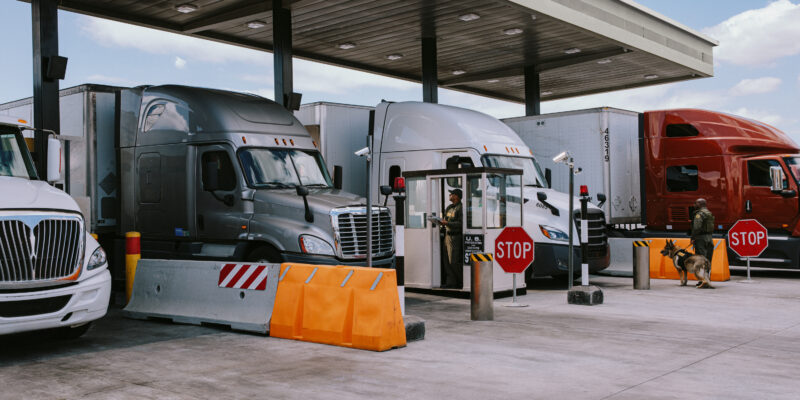A guide to freight trucking rates in 2025

Trucking rates are often an unpredictable element of freight transportation. Because they are directly influenced by the market, trucking rates can be considered a reliable barometer of broader economic conditions. In times of economic prosperity, the surge in consumer spending propels freight demand, driving up rates as capacity becomes strained. Conversely, during economic downturns, reduced consumer spending can lead to overcapacity, prompting carriers to adjust their pricing strategies.
In this guide, we’ll explore everything shippers need to know about trucking rates. As we move through Q1 of 2025, the freight market is showing signs of change. To help mitigate risk and uncertainty, some businesses are adjusting inventory strategies and accelerating imports, and shippers are looking to lock in lower rates and eliminate unnecessary trucking expenses. Shippers can achieve complete visibility into their carrier selection process and secure competitive rates by leveraging a transportation management system (TMS) and other digital logistics solutions.
What is the average trucking rate in 2025?
Trucking rates are the prices that carriers charge to transport freight from one location to another. They depend on various factors, such as freight supply and demand, fuel costs, distance, type of cargo, and seasonality. Carriers typically list trucking rates as “per mile,” so it’s important for shippers to know the distance between their starting point and delivery destination to calculate an accurate estimate.
The type of truck needed to carry the load is equally important. Dry vans, reefers, and flatbeds all have different benchmarks, so shippers need to consider which type they need to get the most bang for their buck.
Average dry van trucking rate
Dry vans are what most people imagine when thinking of freight trucks. They are used to transport dry goods in a non-temperature controlled trailer. In February 2025, the average spot rate for a dry van was $2.05 per mile, or $2.44 per mile as a contract rate.
Average flatbed trucking rate
Flatbed freight trucks are flat, exposed trailers ideal for transporting large, heavy, or irregularly shaped loads that don’t need to be enclosed or don’t fit in the confines of a traditional enclosed dry van. The average spot rate for a flatbed truck was $2.44, or $3.05 per mile as a contract rate in February 2025.
Average reefer trucking rate
Refrigerated trucks, also called reefers, are climate-controlled vehicles often used to transport produce, pharmaceuticals, and beauty products. Maintaining a set temperature means that reefers typically have higher per mile rates. The average spot rate for a refrigerated truck was $2.39 per mile, or $2.74 per mile as a contract rate in February 2025.
What is influencing current trucking rates?
National average trucking rates are constantly fluctuating, so it’s important for carriers to keep a close eye on how the market evolves as well as understand the factors that can cause these shifts.
Spot market rates are subject to change in real time, depending on freight supply and demand. An increase in rates may be driven by a number of persistent, industry-wide challenges in trucking, such as driver shortage, capacity constraints, and rising operational costs. Spot rates are typically lower than the contract rates, which are negotiated between shippers and carriers for longer-term agreements. While contract rates are also influenced by economic outlook, freight volumes, truck utilization, and inflation, they are typically more consistent. Shippers can take advantage of contract rates to avoid market volatility and ensure they have capacity available at a stable rate when they need it.
Spot and contract rates continue to follow seasonal trends
Coming off the holiday rush and driver time off, spot rates are likely to continue following seasonal trends. There will likely be a decline in spot market demand in February, with rates usually bottoming out by April. Last year, there was a 21 cent per mile drop between January and April.
Even so, it’s expected that spot rates will likely rise gradually after April, with various forecasts expecting a 5% to 23% increase year-over-year. It is also likely that capacity will continue to exit the market until supply and demand improve.
As rates rise and uncertainty around tariffs continue, shippers should solidify relationships with key carriers and keep mitigation strategies top of mind. Shippers are working to protect themselves by maintaining current contracts through the RFP cycle and bidding their entire network versus an individual lane. Maintaining strategic partnerships with carriers will help shippers navigate any volatility in 2025.
First tender acceptance and routing compliance rates fall
The recent market tightening from peak season had notable effects on shipper’s transportation costs, with first tender acceptance rates falling below 90%. Routing compliance also fell to 91%. These are some of the lowest levels since mid-2022. Costs over the primary carrier also increased to 4.2%.
While it’s expected that spot and contract rates will rise, shippers should continue working to maintain higher FTA rates by building productive relationships at the lane level. Carriers are more likely to accept a tender the longer a rate has been in place and benchmark a shipper’s network to pinpoint underpriced or overpriced lanes.
What factors go into the freight rate calculation
Freight trucking rates are meticulously calculated through a dynamic process that accounts for a number of factors. These variables work together to create a comprehensive pricing structure that accurately reflects the complexities of modern freight transportation.
Distance
Initially, the distance between the origin and destination serves as a foundational parameter, influencing the baseline cost due to fuel consumption, driver wages, and vehicle maintenance. Longer distances often result in higher rates due to increased fuel, maintenance, and labor costs associated with longer journeys.
Weight or volume
The weight or volume of the cargo being transported directly impacts the operational costs of transporting goods. Heavier loads necessitate more fuel consumption, increased wear and tear on the vehicle, and potential limitations on the amount of cargo that can be transported in a single trip, all of which contribute to higher rates to cover these additional expenses. Larger, bulkier items may occupy a significant amount of space, potentially limiting the overall capacity for other shipments and affecting the carrier’s ability to optimize their routes.
Freight class or type
The type of cargo being shipped and its classification according to industry standards (such as the National Motor Freight Classification) also play a role in rate determination. Different types of cargo have varying levels of difficulty in handling, potential for damage, and industry-specific requirements, which can affect pricing.
Other elements, including equipment, delivery urgency, prevailing fuel prices, tolls, and any supplementary services required, can also impact rates. Uber Freight’s algorithm adjusts in real time to fluctuations in the market, allowing shippers to access current rates they can lock in immediately—without risk of fluctuations down the line.
Uber Freight’s pricing algorithm accounts for factors like the day of the week, time of day, weather, and even seasonality. We also make sure to consider how quickly loads are being booked. If more loads are booked than normal, prices may decrease. If fewer loads are being booked than normal, prices may increase. Learn more about how Uber Freight’s pricing works.
How to estimate freight rates
Using the factors that affect freight trucking rates, shippers can estimate how much it will cost to deliver a specific load.
Shippers should compile comprehensive details about the shipment, including the origin and destination addresses, dimensions, weight, and any special requirements or handling instructions.
- Using the origin and destination addresses, shippers can estimate the mileage of the shipment. For a more accurate estimation, shippers should use precise mapping tools or software.
- Paying close attention to any specific handling requirements, shippers can identify the most suitable type of equipment for the cargo, such as dry van, flatbed, or reefer. Different types have varying rate structures, with reefers often being the most costly.
- Using a current average “per mile” rate for the region of shipment, shippers can estimate the overall cost to ship the goods from point A to point B. Because rates fluctuate in real time, shippers should keep a close eye on how trends might affect their estimates.
For best results estimating a trucking rate, shippers can request and compare quotes from different brokerages and carriers. Shippers looking for immediate information and results can leverage Uber Freight’s instant quote tool, which accurately calculates rates based on type of shipment and pickup and dropoff zip codes. The quote you receive is based on up-to-date market trends. On the Uber Freight Shipping platform, you can lock in that rate instantly. Unlike traditional load-booking processes, no changes can be made to the rate once you secure it—the rate you book is the rate you pay.
Tips for getting the best trucking rate
Securing competitive trucking rates is crucial for shippers of all sizes to keep costs down and protect their bottom line. Digital tools can help businesses find the best rates, regardless of shipment type. Using Uber Freight Shipping or TMS, shippers can access rates from multiple carriers, lock them in ahead of time, and build fruitful, long-standing relationships with their carrier partners and our logistics experts.
Plan ahead
Shippers should plan in advance to gain additional flexibility in rates and carriers. Last-minute shipments can lead to rush fees and limited carrier availability, potentially driving up costs. By planning ahead, you can explore different carrier options, negotiate effectively, and secure a better rate.
Using Uber Freight’s lane explorer tool, shippers can take a more proactive, strategic approach to their transportation process. It allows shippers to lock in rates up to two weeks in advance. They can even see rates across a 14-day window to select the best possible carrier for their shipment.
Explore multiple options
By comparing offers from different providers, shippers can gauge the market rate and be more selective. While the lowest quote might not always be the best option, shippers have the flexibility to evaluate other important variables like carrier reputation, service quality, and additional services provided. Weighing costs and benefits, shippers can choose the rate that offers them the best bang for their buck depending on the shipment details.
As one of the largest freight networks in the country, Uber Freight offers shippers access to multiple, instant carrier spot and contract quotes as part of our suite of shipper solutions, including our TMS. Shippers can choose from our network of carriers of all sizes across the country in Uber Freight Shipping or TMS—or collaborate with our team of experts to find the right fit for them.
Build relationships
Building strong relationships with carriers can lead to more favorable rates over time. Regular shipping needs or a consistent volume of freight can indicate to carriers that you are a valued customer. Open communication, transparent expectations, and reliable payments help establish trust and loyalty with your shipping partners.
Uber Freight’s robust network of carriers on our platform wasn’t built overnight. Our team of experts has long-standing relationships with a variety of carriers. By deploying our managed transportation services, Uber Freight’s team becomes a partner, allowing access to transparent carrier rates.
Small and mid-sized businesses can also take advantage of Uber Freight’s network. Our rate lock tool allows shippers using Uber Freight Shipping to secure the same transparent rates as larger enterprises with a short-term commitment and the flexibility they need.
Finding the best rates with Uber Freight
Ready to take advantage of transparent carrier rates to drive your business forward? Uber Freight’s offerings connect you with a vast network of carriers, ensuring access to up front trucking rates that align with your budget. With accurate, real-time quotes and the power to compare options, Uber Freight empowers you to make informed decisions, optimize your logistics, and secure the best rates for your shipments. Sign up today to get an instant quote.



